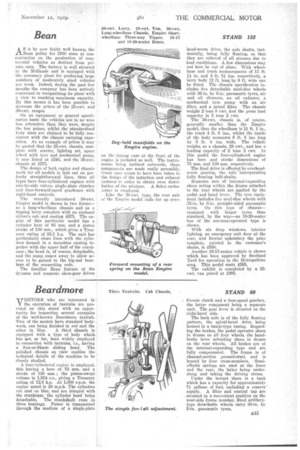Bean
Page 153

If you've noticed an error in this article please click here to report it so we can fix it.
A S is by now fairly well known, the 1-1Betra policy for 1930 aims at concentration on the production of commercial vehicles as distinct from private cars. The factory is well situated in the Midlands and is equipped with the necessary plant for producing large numbers of moderately sized vehicles per week. Indeed, during the past few months the company has been actively concerned in reorganizing its plant with a view to reaching maximum capacity. By this means it has been possible to decrease the prices of the 25-cwt. and 30-cwt. ranges.
On an equipment or general specification basis the vehicles are in no wise less attractive than they were, despite the low prices, whilst the standardized body sizes are claimed to be fully consistent with the chassis carrying capacities. As an example of prices it may be quoted that the 25-cwt. chassis, complete with starter, lighting set, spare wheel with tyre and mechanical pump, is now listed at £245, and the 30-cwt. chassis at £275.
The design of both engine and chassis work for all models is laid out on perfectly straightforward lines, thus all types have four-o.ylindered engines with side-by-side valves, single-plate clutches and four-forward-speed -gearboxes with right-hand controls.
The recently introduced 50-cwt.
mpire model is shown in two forms— as a long-wheelbaSe chassis and as a tipping lorry complete with an enclosed driver's cab and costing £675. The engine of this particular model has a cylinder bore of 95 ram, and a piston stroke of 130 mm., which gives a Treasury rating of 22.3 h.p. The unit has particularly clean lines with the cylinders formed in a monobloe casting together with the upper half of the crankcase; the head is, of 'course, detachable, and the sump comes away to allow access to be gained to the big-end bearings of the connecting rods.
The familiar Bean feature of the dynamo and magneto skew-gear drives on the timing. case at the front of the engine is included as well. The instruments being inclined outwards, these components are made really accessible. Great care seems to have been taken in the design of the induction and exhaust systems in order to obtain even distribution of the mixture. A Solex carburetter is employed.
Like the 30-ewt. type, the roar axle oi' the Empire model calls for an over
head-worm drive, the axle shafts, incidentally, being fully floating, so that they are relieved of all stresses due to load conditions. A few dimensions may not here be out of place. With wheelbase and track measurements of 13 ft. 1-1 in. and 4 ft. 8i ins, respectively, a lorry body 12 ft. long by 6 ft. wide can be fitted. The chassis specification includes five detachable steel-disc wheels with 36-in. by 8-in, pneumatic tyres, air and oil cleaners, an oil radiator, a mechanical tyre pump with an air filter, and a petrol filter. The chassis weighs 2 tons 8 cwt. find the gross load capacity is 3 tons 2 cwt.
The 30-cwt. chassis is, of course, generally smaller, than the Empire model, thus the wheelbase is1.1 ft. 1 in., the track 4 ft. 8 ins., whilst the inside of the body measures 8 ft. 8 ins, long by 5 ft. 4 ins. wide. The vehicle weighs, as a chassis, 28 cwt., and has a loading capacity of 2 tons 2 cwt. In this model the four-cylindered engine has bore and stroke dimensions of 75 mm. and 130 ram. respectively.
The final drive is effected by overheadworm gearing, the axle "incorporating folly floating half-shafts.
Separate sets of internal-expanding shoes acting within the drums attached to the rear wheels are applied by the pedal and hand lever. The tyre equipment includes five steel-disc wheels with 32-in. by 6-in, straight-sided pneumatic tyres. On this type of chassis— equipped with larger tyres than standard, by the way—an 18-20-seater bus of the one-man-operated type is shown.
With six drop windows, interior lighting, an emergency exit door at the rear, and Rexine upholstery the price complete, painted to the customer's' choice, is £550.
Another 16-17-seater vehicle is shown which has been approved by Scotland Yard for operation in the Metropolitan area. This model costs £595.
The exhibit is completed by a 25Cwt. van priced at £295.








































































































































































































































































































































